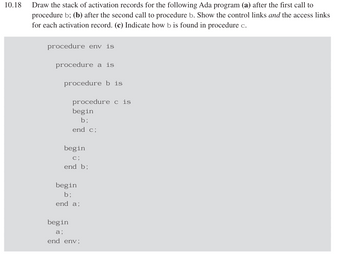
C++ for Engineers and Scientists
4th Edition
ISBN: 9781133187844
Author: Bronson, Gary J.
Publisher: Course Technology Ptr
expand_more
expand_more
format_list_bulleted
Question

Transcribed Image Text:10.18
Draw the stack of activation records for the following Ada program (a) after the first call to
procedure b; (b) after the second call to procedure b. Show the control links and the access links
for each activation record. (c) Indicate how b is found in procedure c.
procedure env is
procedure a is
procedure b is
procedure cis
begin
b;
end c;
begin
c;
end b;
begin
b;
end a;
begin
a;
end env;
Expert Solution
This question has been solved!
Explore an expertly crafted, step-by-step solution for a thorough understanding of key concepts.
Step by stepSolved in 2 steps with 2 images

Knowledge Booster
Similar questions
- 4. Repeat Programming Exercise 3 by declaring numl, num2, and num3, and average of type double. Store 75.35 into numl, -35.56 into num2, and 15.76 into num3.arrow_forward(For thought) a. What’s an advantage of namespaces? b. What’s a possible disadvantage of namespaces?arrow_forward(Conversion) a. Write a C++ program to convert meters to feet. The program should request the starting meter value, the number of conversions to be made, and the increment between metric values. The display should have appropriate headings and list the meters and the corresponding feet value. If the number of iterations is greater than 10, have your program substitute a default increment of 10. Use the relationship that 1 meter = 3.281 feet. b. Run the program written in Exercise 6a on a computer. Verify that your program begins at the correct starting meter value and contains the exact number of conversions specified in your input data. c. Modify the program written in Exercise 6a to request the starting meter value, the ending meter value, and the increment. Instead of the condition checking for a fixed count, the condition checks for the ending meter value. If the number of iterations is greater than 20, have your program substitute a default increment of (ending value - starting value) / 19.arrow_forward
arrow_back_ios
arrow_forward_ios
Recommended textbooks for you
 C++ for Engineers and ScientistsComputer ScienceISBN:9781133187844Author:Bronson, Gary J.Publisher:Course Technology Ptr
C++ for Engineers and ScientistsComputer ScienceISBN:9781133187844Author:Bronson, Gary J.Publisher:Course Technology Ptr C++ Programming: From Problem Analysis to Program...Computer ScienceISBN:9781337102087Author:D. S. MalikPublisher:Cengage Learning
C++ Programming: From Problem Analysis to Program...Computer ScienceISBN:9781337102087Author:D. S. MalikPublisher:Cengage Learning Microsoft Visual C#Computer ScienceISBN:9781337102100Author:Joyce, Farrell.Publisher:Cengage Learning,
Microsoft Visual C#Computer ScienceISBN:9781337102100Author:Joyce, Farrell.Publisher:Cengage Learning, Systems ArchitectureComputer ScienceISBN:9781305080195Author:Stephen D. BurdPublisher:Cengage LearningProgramming Logic & Design ComprehensiveComputer ScienceISBN:9781337669405Author:FARRELLPublisher:Cengage
Systems ArchitectureComputer ScienceISBN:9781305080195Author:Stephen D. BurdPublisher:Cengage LearningProgramming Logic & Design ComprehensiveComputer ScienceISBN:9781337669405Author:FARRELLPublisher:Cengage

C++ for Engineers and Scientists
Computer Science
ISBN:9781133187844
Author:Bronson, Gary J.
Publisher:Course Technology Ptr

C++ Programming: From Problem Analysis to Program...
Computer Science
ISBN:9781337102087
Author:D. S. Malik
Publisher:Cengage Learning

Microsoft Visual C#
Computer Science
ISBN:9781337102100
Author:Joyce, Farrell.
Publisher:Cengage Learning,

Systems Architecture
Computer Science
ISBN:9781305080195
Author:Stephen D. Burd
Publisher:Cengage Learning

Programming Logic & Design Comprehensive
Computer Science
ISBN:9781337669405
Author:FARRELL
Publisher:Cengage
